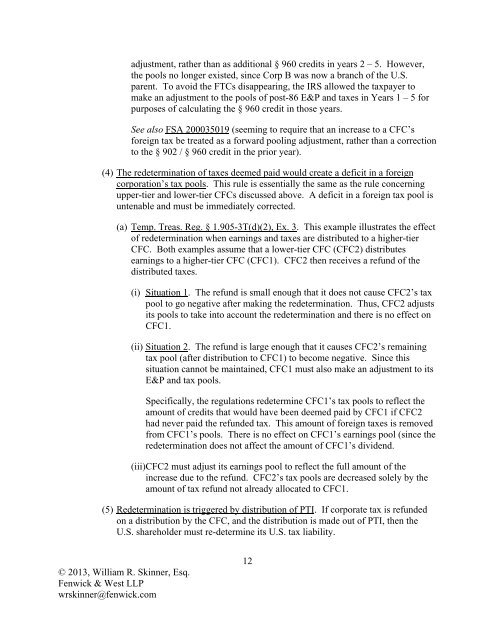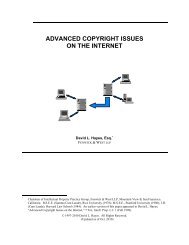Foreign Tax Redeterminations under § 905(c) - Fenwick & West LLP
Foreign Tax Redeterminations under § 905(c) - Fenwick & West LLP
Foreign Tax Redeterminations under § 905(c) - Fenwick & West LLP
You also want an ePaper? Increase the reach of your titles
YUMPU automatically turns print PDFs into web optimized ePapers that Google loves.
adjustment, rather than as additional § 960 credits in years 2 – 5. However,<br />
the pools no longer existed, since Corp B was now a branch of the U.S.<br />
parent. To avoid the FTCs disappearing, the IRS allowed the taxpayer to<br />
make an adjustment to the pools of post-86 E&P and taxes in Years 1 – 5 for<br />
purposes of calculating the § 960 credit in those years.<br />
See also FSA 200035019 (seeming to require that an increase to a CFC’s<br />
foreign tax be treated as a forward pooling adjustment, rather than a correction<br />
to the § 902 / § 960 credit in the prior year).<br />
(4) The redetermination of taxes deemed paid would create a deficit in a foreign<br />
corporation’s tax pools. This rule is essentially the same as the rule concerning<br />
upper-tier and lower-tier CFCs discussed above. A deficit in a foreign tax pool is<br />
untenable and must be immediately corrected.<br />
(a) Temp. Treas. Reg. § 1.<strong>905</strong>-3T(d)(2), Ex. 3. This example illustrates the effect<br />
of redetermination when earnings and taxes are distributed to a higher-tier<br />
CFC. Both examples assume that a lower-tier CFC (CFC2) distributes<br />
earnings to a higher-tier CFC (CFC1). CFC2 then receives a refund of the<br />
distributed taxes.<br />
(i) Situation 1. The refund is small enough that it does not cause CFC2’s tax<br />
pool to go negative after making the redetermination. Thus, CFC2 adjusts<br />
its pools to take into account the redetermination and there is no effect on<br />
CFC1.<br />
(ii) Situation 2. The refund is large enough that it causes CFC2’s remaining<br />
tax pool (after distribution to CFC1) to become negative. Since this<br />
situation cannot be maintained, CFC1 must also make an adjustment to its<br />
E&P and tax pools.<br />
Specifically, the regulations redetermine CFC1’s tax pools to reflect the<br />
amount of credits that would have been deemed paid by CFC1 if CFC2<br />
had never paid the refunded tax. This amount of foreign taxes is removed<br />
from CFC1’s pools. There is no effect on CFC1’s earnings pool (since the<br />
redetermination does not affect the amount of CFC1’s dividend.<br />
(iii)CFC2 must adjust its earnings pool to reflect the full amount of the<br />
increase due to the refund. CFC2’s tax pools are decreased solely by the<br />
amount of tax refund not already allocated to CFC1.<br />
(5) Redetermination is triggered by distribution of PTI. If corporate tax is refunded<br />
on a distribution by the CFC, and the distribution is made out of PTI, then the<br />
U.S. shareholder must re-determine its U.S. tax liability.<br />
© 2013, William R. Skinner, Esq.<br />
<strong>Fenwick</strong> & <strong>West</strong> <strong>LLP</strong><br />
wrskinner@fenwick.com<br />
12

















